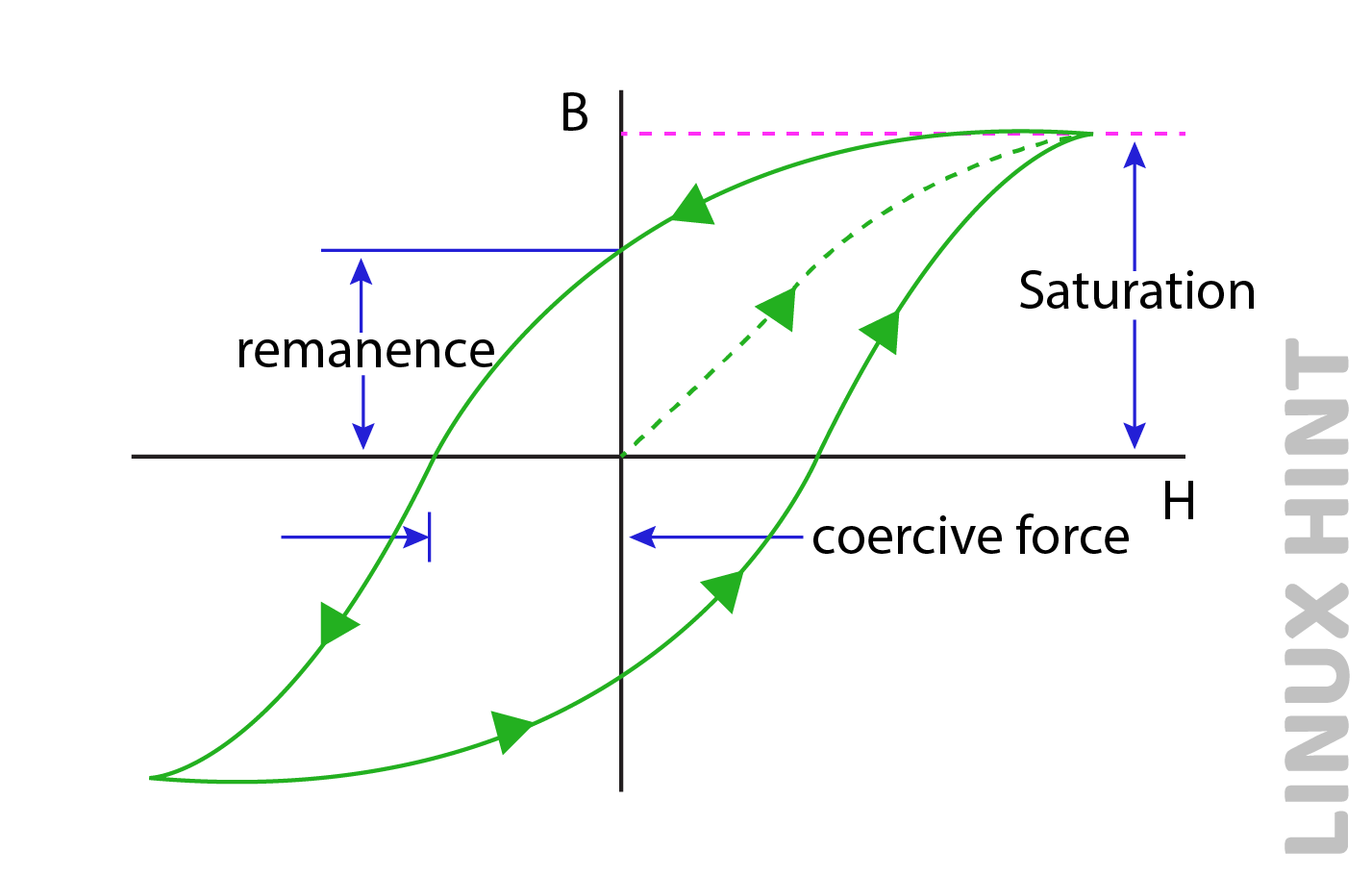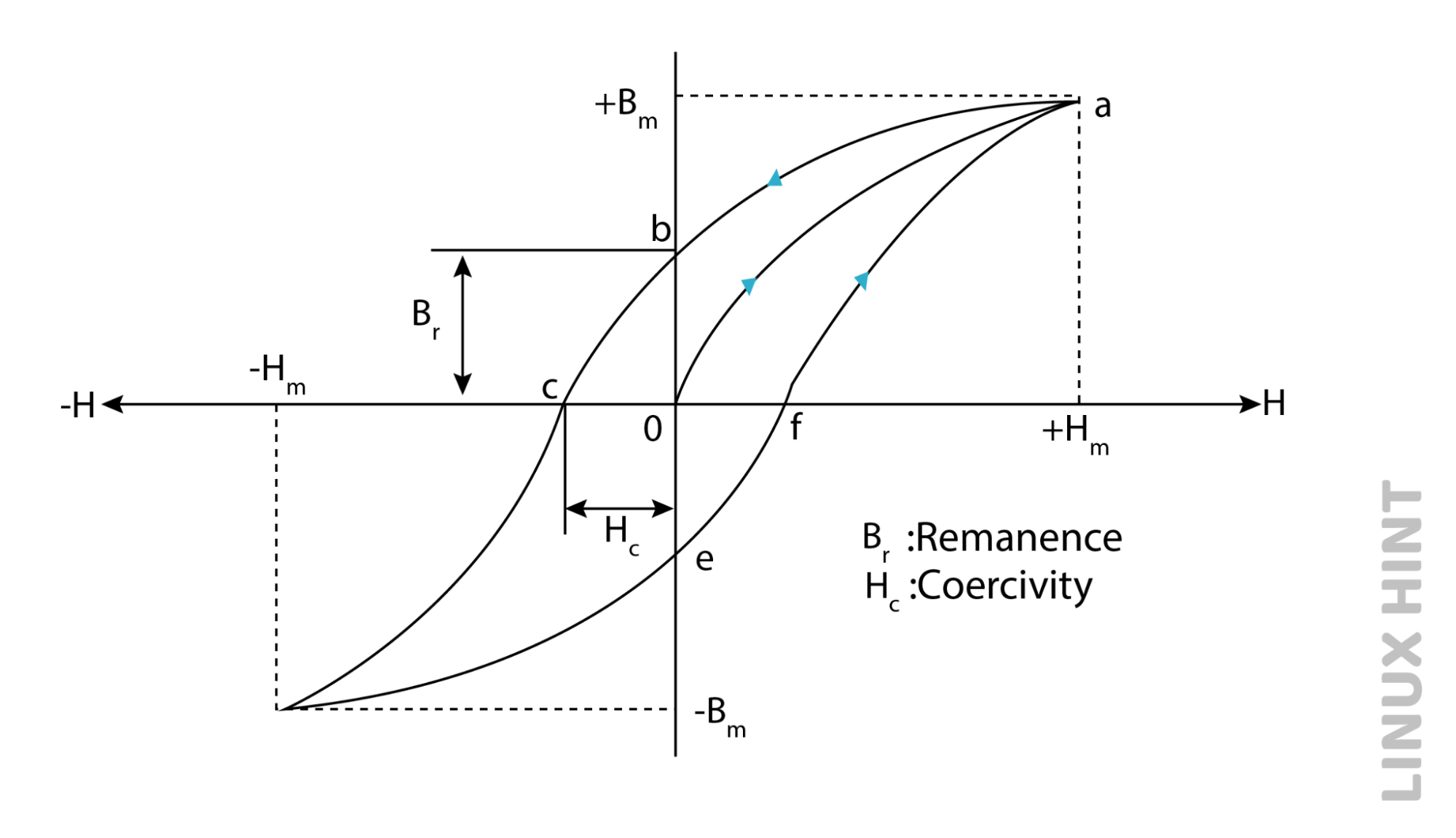Hysteresis means “lagging” is the property of the ferromagnetic materials by which the magnetic flux lagged in the ferromagnetic material after removing the magnetic field from them. When this external magnetic field is removed, most of the atoms retained in their magnetic state and material get magnetized. This phenomenon is called hysteresis.
Hysteresis Loop and B-H Curve
The graph of the magnetizing force H and the flux density B is a four-quadrant curve, and this curve is called B-H curve. This graphical representation tells us about the different magnetic properties of the material such as permeability, coercive, reluctance and residual flux.

Consider a magnetic material as a core of the coil. On applying DC power supply through a variable resistor, the current through the coil vary accordingly. Magnetizing force is directly proportional to the current and given by,
Where H is the magnetizing force. On increasing the current I, magnetic force H increases, and hence magnetic flux density B increases. At certain value of B, all the atoms in the core material get aligned in the direction of magnetic field and magnetized completely. This point is called saturation point and there will be no change in the magnetization on further increase in the current.
If we cut off the power supply, the current I and magnetizing force H decreased to zero, but some of the atoms in the core material remain aligned and show magnetism in the material. This property of the core material to remain magnetized after removing the magnetizing force is called “Retentivity”.
B-H Curve
From 0 to a
On applying the power supply, current changes in the coil from zero to some certain value the magnetic force H increases and hence the magnetic flux B increases, and both follow the path 0-a in the graph. At certain value of magnetic flux B all the atoms get magnetized and there is no change in the atoms of the core material on further applying the magnetic field. This maximum flux density is Bmax, and the magnetizing force is Hmax.
From a to b
Now, on decreasing the current, the magnetic force H decreases and hence the magnetic flux B decreases. But in this case the B and H does not follow the previous path, instead they follow path “a-b” in the graph.
At point “b” current I and magnetic force H is zero, but B is not zero, this lagging of B behind H is called hysteresis and this value of magnetic flux density B lagging the H is called residual magnetism Br.
From b to c
When the direction of current is reversed, H get reversed and the value of Br decreases following the bath “b-c”. At point “c”, Br becomes zero. The negative value of “H” at point c where the value of B is zero, is called “Coercive force”.
From c to d
On further increasing the current in reverse direction, H and B get reversed and follow the path “c-d” and at a certain value of reverse current, the value of B becomes maximum in the reverse direction and saturation occurs at point “b”.
From d to e
Now, if the current increases from negative value to zero, H increases. At point “e” both current I and magnetic force becomes zero, but B is not zero and have certain value in negative. Point “e” in the graph gives the negative value of Residual Magnetism (-Br).
From e to f
By increasing the value of current, the value of H increases. B and H follow the path “e-f”. At point “f” both current I and magnetizing force H has a certain value, but B is zero.
From f to a
Again, on further increase in the current I, the value of H and B increases and follow the path “f-a”. At point “a” again, saturation occurs and all the atoms in the core material get magnetized and aligned in the direction of the magnetic field.
Hysteresis loop
This graph between magnetic flux density B and the magnetizing force H is called B-H curve and the closed path followed by B and H as the current changes from zero to positive, positive to zero, zero to negative, negative to zero and again zero to positive is called hysteresis loop.
Different ferromagnetic materials give different size and shape of the hysteresis loop. Soft ferromagnetic material gives narrow hysteresis loop, and they can easily be magnetized and demagnetized and are suitable for use in the transformers.
Retentivity
Retentivity is the property of any material by which it retains magnetization after removal of induced magnetic field.
Coercivity
The strength of magnetic field applied in reverse direction needed to fully demagnetize the material is known coercivity. The coercive force must be applied to fully demagnetized the material after removing the current. The work is done on it and the energy is dissipated from the material in the form of heat. The heat dissipated from the material; is known as hysteresis loss, given by Hc in the B-H curve.
Conclusion
Magnetic flux lagged in the ferromagnetic material after removing the magnetic field from them is called hysteresis. A force is required to completely demagnetize the ferromagnetic material, called coercive force, and work is done on it which causes dissipate of heat in it. The graphical representation between magnetizing force H and magnetic flux density B gives B-H curve and the closed path followed by B and H is called hysteresis loop.



